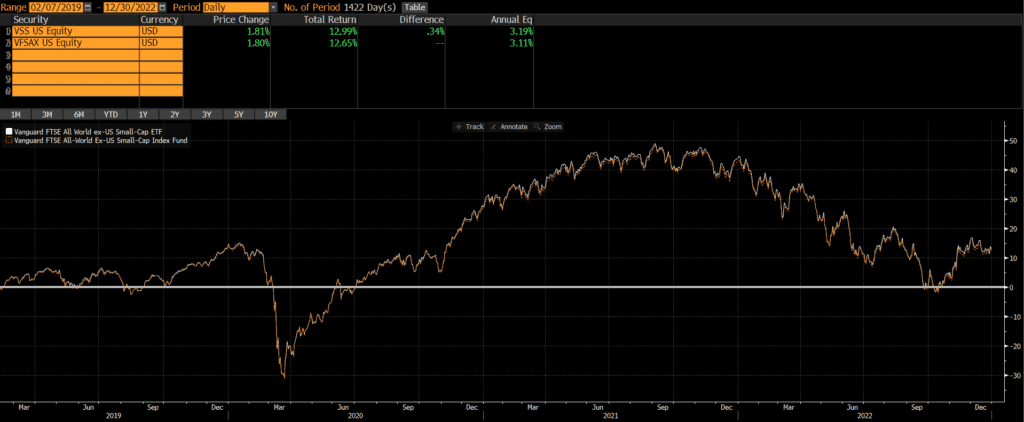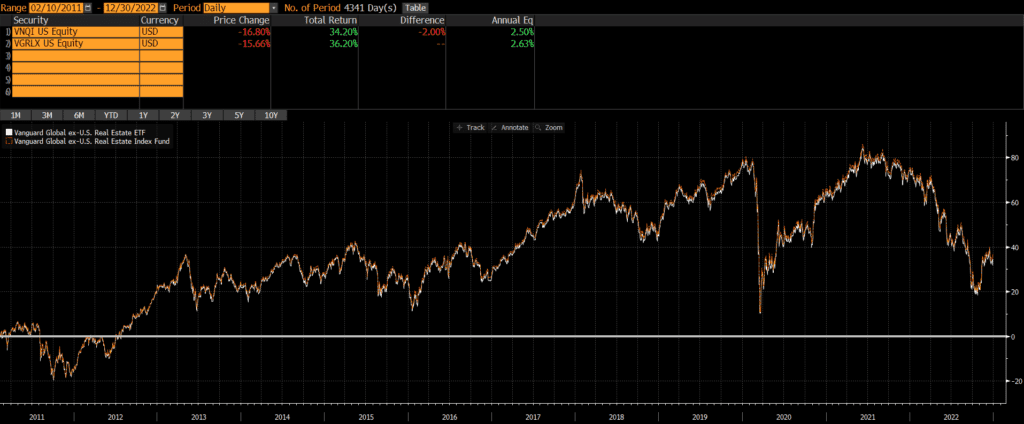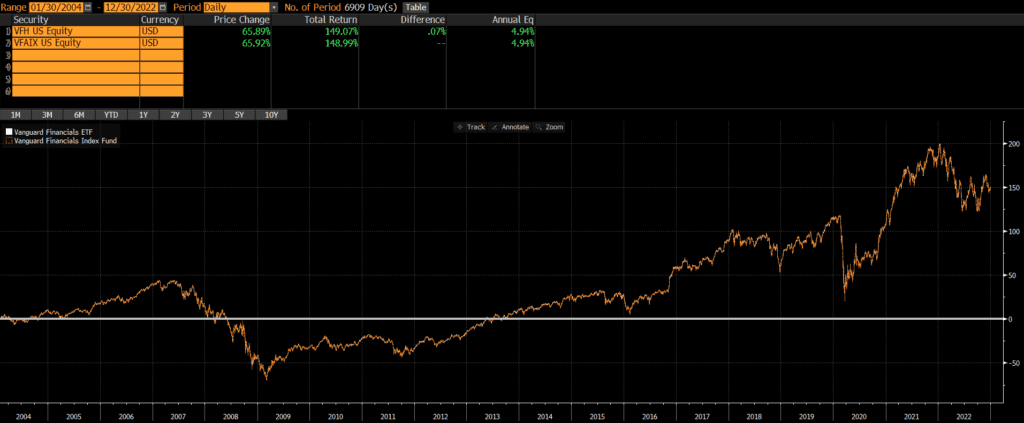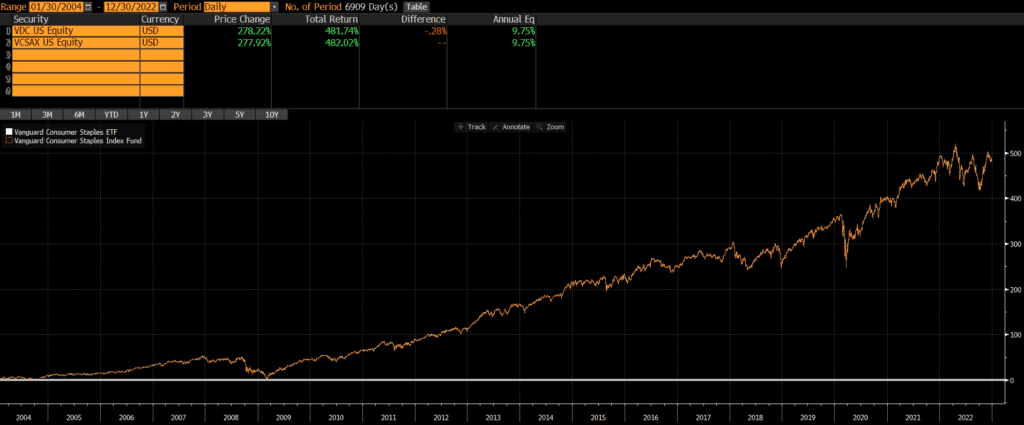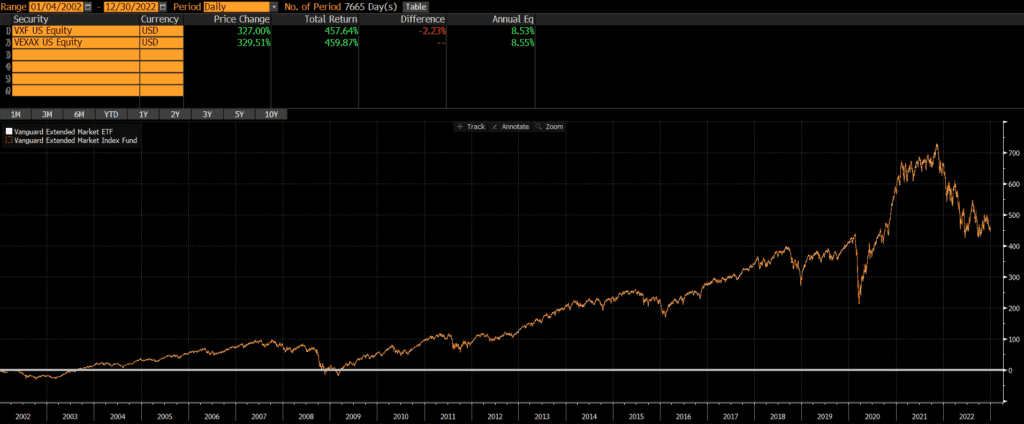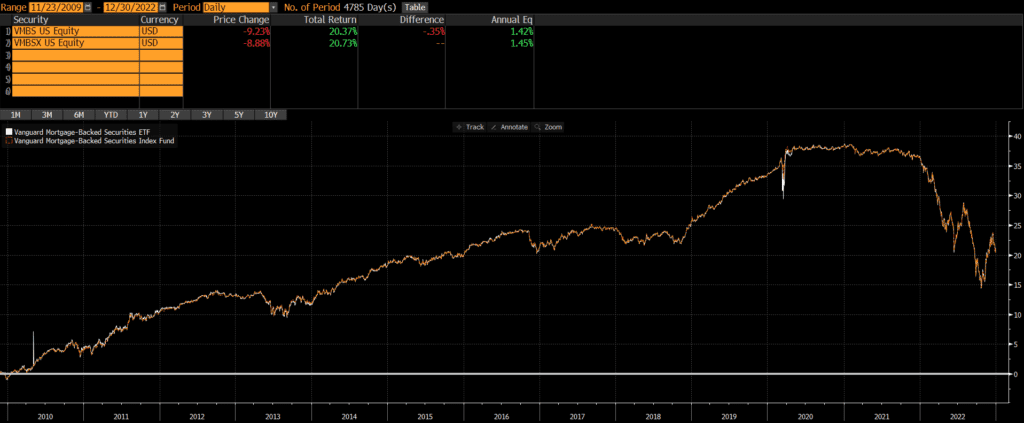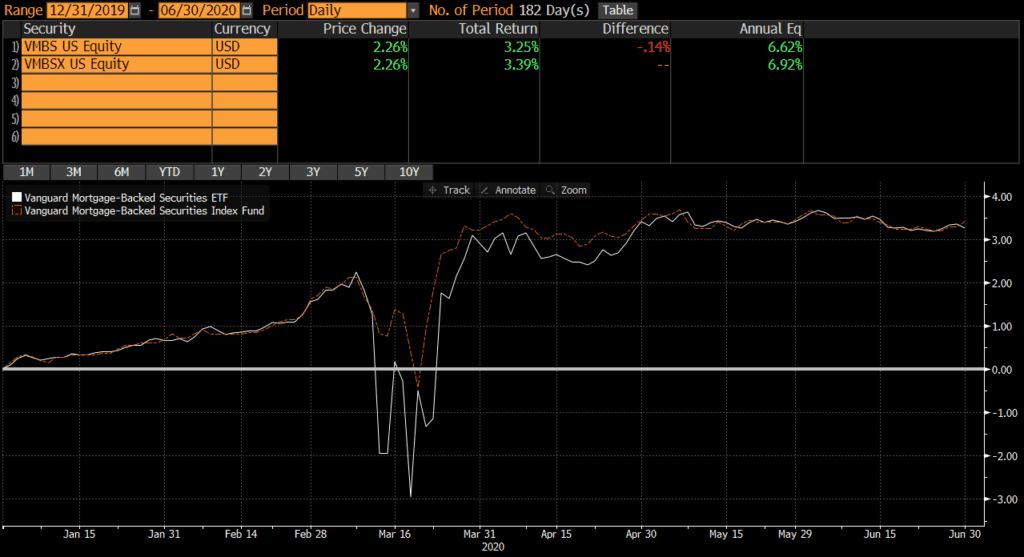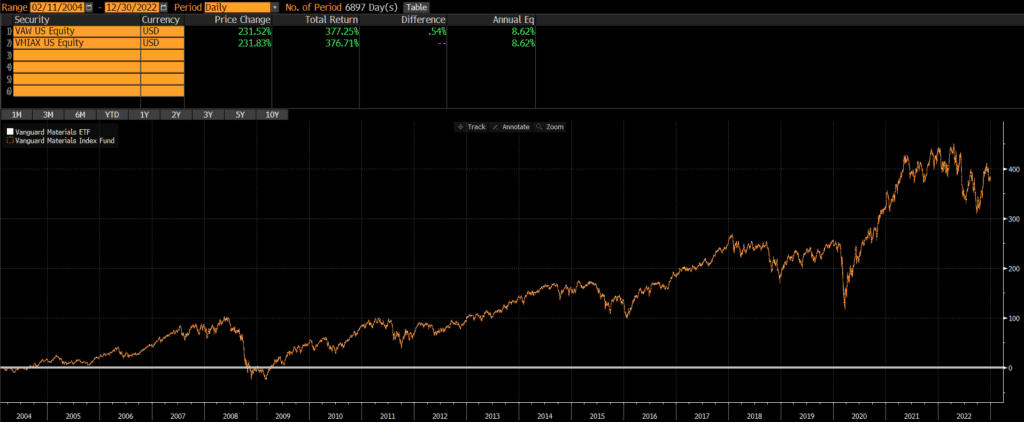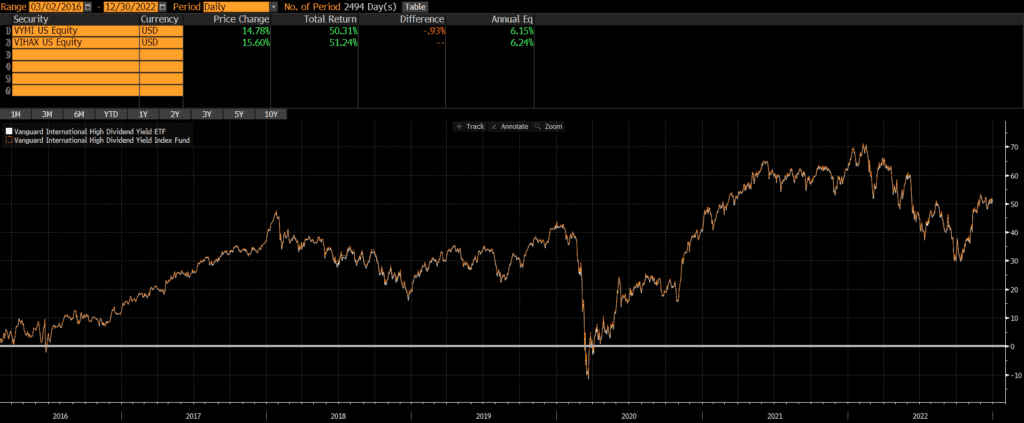VIGI vs VIAAX
The Vanguard International Dividend Appreciation Index Fund (Admiral Shares) (symbol VIAAX) and the Vanguard International Dividend Appreciation ETF (symbol VIGI) are two of the largest and most popular international dividend-oriented index funds. Some compare VIAAX vs VIGI not realizing that they are just two different share classes of the same portfolio.
A quick reminder that this site does NOT provide investment recommendations. Fund comparisons (such as this one) are not conducted to identify the “best” fund (since that will vary from investor to investor based on investor-specific factors). Rather, these fund comparison posts are designed to identify and distinguish between the fund details that matter versus the ones that don’t.
The Short Answer
VIAAX and VIGI are different share classes of the same portfolio, which is made possible by Vanguard’s ETF share class structure. The decision to buy one or the other depends on investor-specific factors (some of which are listed below).
The Longer Answer
Vanguard ETFs are structured as share classes of their mutual funds. This is a patented structure that is scheduled to expire in 2023, so we may see this structure more frequently in the near future. In other words, VIAAX and VIGI are not two funds pursuing an identical strategy; they are the same fund!
Historical Performance: VIAAX vs VIGI
VIGI was launched on February 25, 2016, while VIAAX was launched on March 2, 2016. Since the common inception date (the latter of the two inception dates), performance has been close: 7.07% vs 7.22% annually. Despite changes in fees and expenses over this time period, there is only about a 1.5% difference in cumulative performance since inception! Looking at the chart of VIAAX vs VIGI below, it is obvious that they are identical.
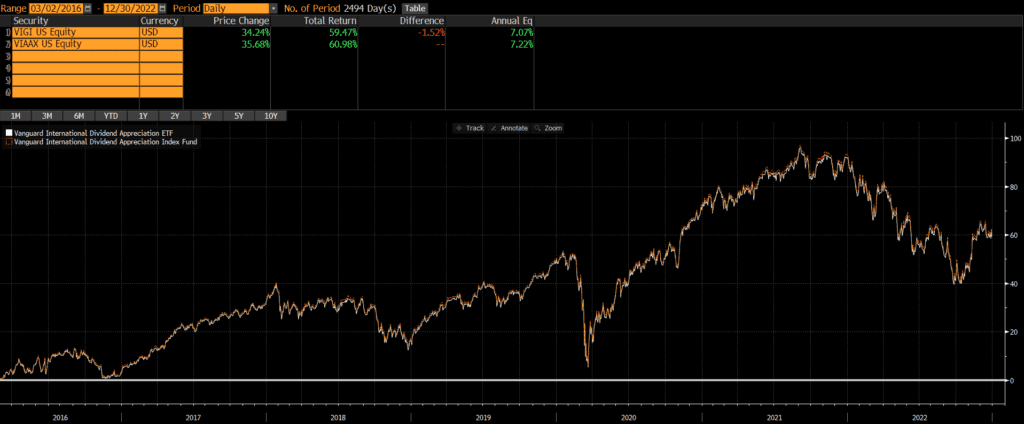
Differences Between VIAAX and VIGI
Since the two funds are actually two share classes of the same fund, I will skip the usual comparisons here. The geographic exposures, sector weights, market cap coverage so on is identical because the two funds are shares in the same portfolio. There are some resources on the internet indicating otherwise, but these are incorrect.
Some investors may point out that the expense ratios between Vanguard’s Admiral Shares and Vanguard’s ETFs differ. This is true, but it is also reflected in the net performance chart above. At a certain level, differences in expense ration do not matter. A small absolute difference (in basis points) is essentially meaningless (even if it appears large on a percentage basis) and is often smaller than the bid-ask spread (see transaction costs below). Expenses do matter, but I would not sweat infinitesimally small differences (and they’ll show up in net performance anyways).
Factors to Consider
Transaction Costs
ETFs are free to trade at many brokers and custodians, including Vanguard. However, many brokers and custodians still charge commissions and/or transaction fees to buy/sell mutual funds. To my knowledge, Vanguard does not participate in the pay-to-play arrangements that would allow their mutual funds to trade for free on many platforms. So if an investor account is at Vanguard, it is free to trade VIAAX or VIGI. However, only VIGI is free to trade in non-Vanguard accounts.
Unfortunately, Vanguard does charge a .25% fee on both purchases and redemptions of VIAAX, no matter where the account is held. So investors should consider whether their allocation will be a one-time purchase or averaged in over time, as that may help them determined whether the mutual fund or ETF is a better choice.
There is a bid-ask spread when trading ETFs, but this spread is typically less than .05% for VIGI and individual investor trades will not generally be large enough to “move” the market. In the case of VIGI, individual investors should not have a problem trading.
Tax Efficiency & Capital Gain Distributions
ETFs are typically more tax-efficient than mutual funds, due to their ability to avoid realizing capital gains through like-kind redemptions (a process that is beyond the scope of this post). However, since Vanguard ETFs are a share class of their mutual funds, the mutual funds are able to benefit from this feature of the ETF. In other words, VIGI is able to extend its tax benefits to VIAAX. A more in-depth explanation of Vanguard mutual fund tax-efficiency can be found here.
Both VIGI and VIAAX made their first-ever capital gains distributions in 2021. Its not clear whether the funds will make additional ones, but it is possible. The important thing to note is that each fund should be identical in terms of capital gains distributions. I noticed some posts on the internet saying that VIGI is more tax-efficient than VIAAX, but this incorrect as both funds have made equivalent (on a percentage basis) capital gains distributions recently.
Tax Loss Harvesting
My personal preference is to keep a portfolio entirely mutual funds or entirely ETFs, due to the mechanics of settlement during tax loss harvesting. If an ETF has declined in value and an investor sells it, the trade and cash proceeds will not settle for two business days (T+2). That investor may want to “replace” the sold ETF immediately and attempt to buy another ETF or mutual fund simultaneously.
However, mutual funds settle on T+1 basis, so cash for the mutual purchase would be due in one business day (which is one day earlier than the cash from the ETF sale is received). This can obviously cause problems and (even though this issue can be addressed with careful planning) I find it easier to keep accounts invested in similar vehicles. In this case, if a portfolio is all mutual funds, I might lean more towards VIAAX. If all ETFs, I might lean more towards VIGI.
On this topic, investors should probably avoid using these two funds as tax loss harvesting substitutes for one another since they would likely be considered “substantially identical.”
Tradability
VIAAX does have a stated minimum initial purchase of $3,000, so that may be a factor for some investors looking to initiate a position. The minimum purchase size for VIGI is typically one share, although fractional shares are becoming more common.
Investors can trade ETFs intraday, as well as in the pre-market and after-hours trading sessions. Investors can only buy/sell mutual funds once per day. This is not necessarily a major factor for long-term investors however.
Final Thoughts: VIAAX vs VIGI
VIAAX and VIGI are literally the same. However, investors should consider the above factors when deciding which one is best for them.
